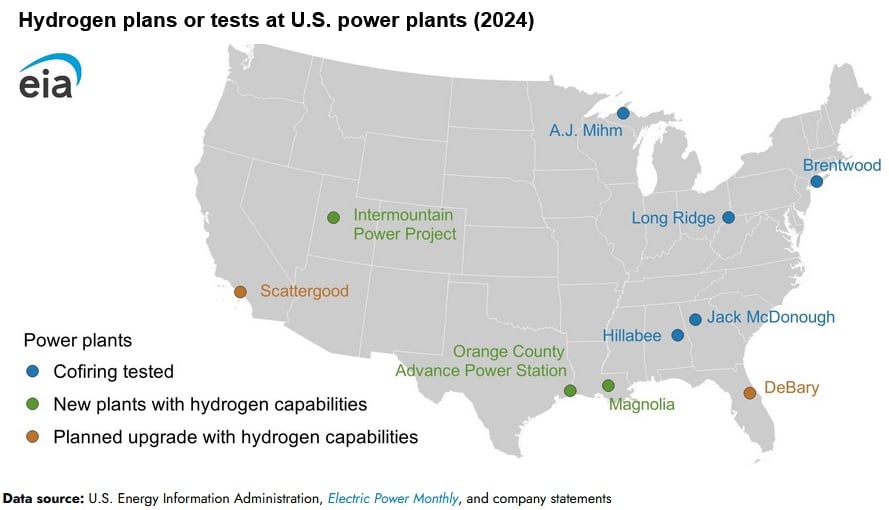Natural Gas Plants Take Early Steps Toward Integrating Hydrogen into Fuel Streams: EIA

Several U.S. natural gas power plants are exploring options to incorporate hydrogen into their operations in response to emissions reduction policies, according to an Sept. 12 report published by the U.S. Energy Information Administration. Hydrogen combustion does not produce carbon dioxide emissions and has garnered interest as an effective tool to support the progress toward emissions reduction goals.
Plant operators are exploring three main approaches: testing hydrogen cofiring at existing facilities, upgrading turbines to accommodate a mix of natural gas and hydrogen, and designing new plants with the capability to use a blend of both fuels.
Natural gas is the largest fuel source utilized to produce power across the U.S., and accounted for 43 percent of power generation during 2023. As it stands, hydrogen usage is not currently extensive or utilized frequently in the plants where it has been tested. Burning a mix of hydrogen with gas for power production is called cofiring, and as the quantity of hydrogen in the blend rises, carbon emissions decline, since hydrogen is less energy dense compared to natural gas.
Two existing plants have announced plans to add cofiring capability by upgrading existing turbines. Duke Energy plans to convert its 74-megawatt (MW) DeBary peaking power plant in Florida to run entirely on hydrogen. Meanwhile, the Los Angeles Department of Water and Power is exploring an upgrade for two units of its Scattergood Generation Station to enable co-firing of 30 percent hydrogen by December 2029, with a potential shift to 100 percent when feasible.
Operators of three new combined-cycle power plants currently under construction are planning to incorporate hydrogen co-firing capabilities. In Utah, the Intermountain Power Agency is replacing a coal-fired plant with an 840-MW natural gas plant that will be able to use a 30 percent hydrogen and 70 percent natural gas blend. Kindle Energy’s 678-MW Magnolia Power Plant in Louisiana, set to start in 2025, aims to cofire up to 50 percent hydrogen. In Texas, Entergy’s 1,158-MW Orange County Advance Power Station, scheduled to begin operations in mid-2026, could cofire up to 30 percent hydrogen, according to trade press reports.
Moreover, a few plants have undergone successful tests of fuel blends containing between 5 percent and 44 percent hydrogen. Notable among these is Constellation Energy’s Hillabee Energy Center in Alabama that conducted a test in May 2023 using a hydrogen blend of up to 38 percent.
Hydrogen usage has been incentivized by a number of state and federal policies aimed at lowering greenhouse gas emissions. The U.S. Energy Department’s Hydrogen and Fuel Cell Technologies Offices recently issued a multi-year program plan identifying the challenges to realize the full potential of clean hydrogen and fuel cells, as well as research, development, and demonstration activities to overcome those challenges in the near-, mid-, and longer-term. The Hydrogen Hubs program and production tax credits established by the 2022 Inflation Reduction Act have bolstered the hydrogen sector.
EnerKnol Pulses like this one are powered by the EnerKnol Platform—the first comprehensive database for real-time energy policy tracking. Sign up for a free trial below for access to key regulatory data and deep industry insights across the energy spectrum.
ACCESS FREE TRIAL


